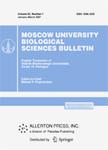版权所有:内蒙古大学图书馆 技术提供:维普资讯• 智图
内蒙古自治区呼和浩特市赛罕区大学西街235号 邮编: 010021

作者机构:Department of Biophysics School of Biology Moscow State University Moscow 119234 Russian Federation
出 版 物:《Moscow University Biological Sciences Bulletin》 (Moscow Univ. Biol. Sci. Bull.)
年 卷 期:2022年第77卷第2期
页 面:92-97页
学科分类:0710[理学-生物学] 0830[工学-环境科学与工程(可授工学、理学、农学学位)] 07[理学] 09[农学]
基 金:State Order of the Government of Russian Federation Lomonosov Moscow State University, MSU, (121032500058-7)
主 题:citrate evolution of photosystems hydrogen peroxide manganese oxygen-evolving complex photosystem II
摘 要:Abstract: One of the main reactions in the process of light energy transformation in oxygenic organisms is the extraction of electrons from water, which are necessary for the light stage of photosynthesis. The light-dependent oxidation of water is carried out by an oxygen-evolving complex (OEC), the catalytic center of which is the cluster Mn4CaO5. OEC is located in photosystem II (PSII) on the lumen side of the thylakoid membrane. The evolutionary origin of the PSII is unclear, as is the origin of the manganese cluster in the OEC. Recently, Johnson et al. (2013) suggested that, in the primary PSII in the Archean period, the cluster Mn4CaO5 was absent, and PSII oxidized not water but Mn (II) cations, i.e., manganese cations were the source of electrons. In the presented work, the authors investigated the possibility of the influence of some environmental factors (citrate and hydrogen peroxide) on the oxidation rate of Mn(II) cations by a PSII that does not contain OEC. It was found that citrate inhibit the oxidation of Mn(II) cations binding them but does not extract Mn cations from OEC. Hydrogen peroxide, on the contrary, significantly increases the oxidation rate of manganese (from 28 ± 2 to 145 ± 7 µmol 2,6-dichlorophenolindophenol mg Chl–1 h–1 in the presence of H2O2). Such effects should be taken into account when investigating the oxidation of manganese cations by the photosystem as a possible source of electrons in the early stages of evolution. © 2022, Allerton Press, Inc.